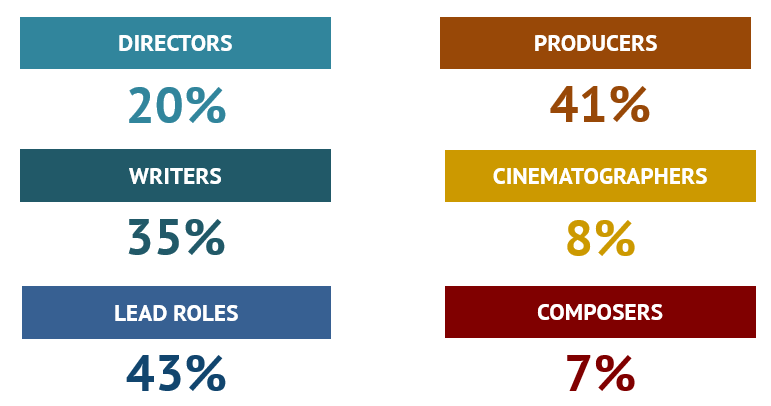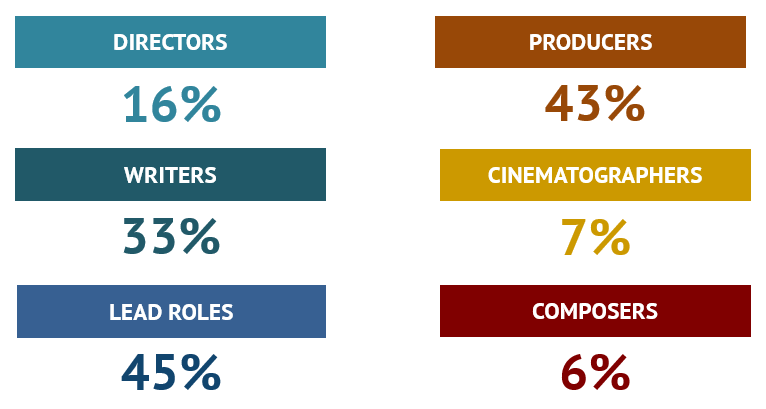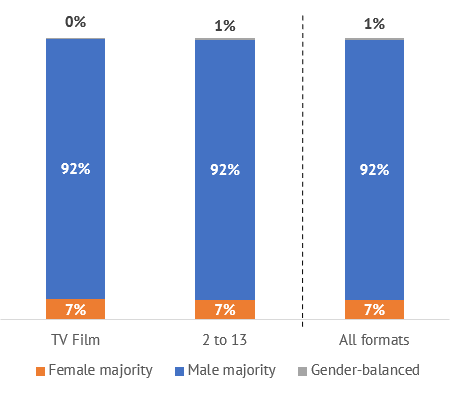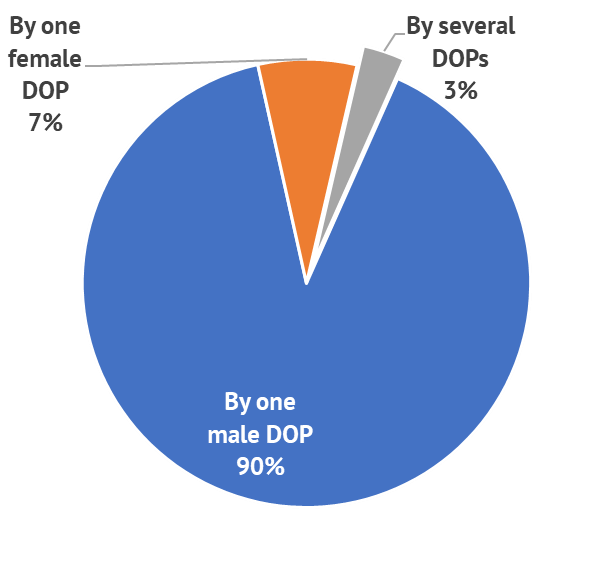Download “Female audiovisual professionals in European TV fiction production” here
This report provides an assessment of the gender imbalance within six audiovisual professional categories in European TV fiction:
- Directors, writers and lead roles of European TV films and TV series (up to 52 episodes per season) broadcast or made available between 2015 and 2019.
- Producers, cinematographers and composers of European TV films and TV series (up to 13 episodes per season) broadcast or made available between 2015 and 2019.
The analysis also explores the gender composition of professional teams and identifies the share of TV titles lead by female-majority teams.
Key insights
Beyond obvious inequalities, this report shows remarkable differences in the audiovisual professional activity depending on the job:
- Women directors collaborated with other directors more often than their male counterparts, and quite often in gender-balanced teams.
- Writers of European TV fiction worked in large groups which were either male-driven or gender balanced.
- For lead roles, data limits made the analysis more delicate (This category analysis builds on IMDB information which provides generally the names for 4 actors, although sometimes even more than 4 names are given. A sample test by the Observatory seems to prove that these 4 names correspond to the first four lead roles). The results were not clear enough to understand who is playing the principal roles. It was clearly an activity performed in groups and teams appeared quite gender balanced.
- Producers worked mainly alone or when teaming up, it was in gender-balanced teams.
- In European TV fiction, cinematographers were mainly men and they work either alone or with other men.
- For composers too, data showed mainly men and working alone; but there were more women hidden in male-driven teams than the opposite.
Our new report aims at answering three methodological questions:
A. How are women represented among active professionals of European TV works?
Share of active female professionals, by professional category (2015-2019)

Source: European Audiovisual Observatory / LUMIERE, Plurimedia
B. What is the weighted share of women in the professional categories of European TV works?
“Weighted” signifies that we calculated the percentages with reference to the number of people working in the respective team.
Weighted share of women in each of the six professional categories analysed, 2015-2019.

Source: European Audiovisual Observatory / LUMIERE, Plurimedia
C. What is the share of audiovisual works by female‑driven teams?
Share of works by female-driven teams, 2015-2019

Source: European Audiovisual Observatory / LUMIERE, Plurimedia
1. Directors of European TV fiction
Between 2015 and 2019, female directors represented 20% of active directors of audiovisual fiction episodes and TV films in the EU (including UK), and this share grew by 5% in that period.
The weighted share of female directors in audiovisual fiction was lower, representing 16%. This is explained by the fact that women were less likely to be the sole director of a work.
Although women were proportionally more likely than men to work in gender-mixed teams, most of these teams were led by men: the share of audiovisual fiction episodes directed by female‑driven teams were just 15%. (‘Female-driven’ refers to works in which at least 60% of team members were women. Works by female-driven teams can be made either: by one individual female; by several female professionals; or by teams of professionals of both genders with a female presence of at least 60%.)
Share of AV fiction episodes by gender composition of directors’ teams, by format (2015-2019)

Source: European Audiovisual Observatory / LUMIERE, Plurimedia
Direction of TV fiction in Europe is a male activity which most men directors accomplish alone.
Gender composition of directors’ teams, (2015-2019)

Source: European Audiovisual Observatory / LUMIERE, Plurimedia
2. Writers of European TV fiction
Between 2015 and 2019, women accounted for 35% of active writers of audiovisual fiction in the EU. However, a woman was less likely the sole writer of an episode or a TV film. Therefore, the weighted share of female writers of audiovisual fiction was lower, representing 33%.
The share of episodes written by female-driven teams was only 24%, because female writers were proportionally more likely than male colleagues to co-write audiovisual fiction and when they did, it was often within teams with a male majority.
Share of AV fiction episodes by gender composition of writers’ teams, by format (2015-2019)

Source: European Audiovisual Observatory / LUMIERE, Plurimedia
68% of TV fiction titles were the work of writers’ teams, of which 36% were written by writers of both genders and 13% by gender-balanced teams of writers.
Gender composition of writers’ teams, (2015-2019)

Source: European Audiovisual Observatory / LUMIERE, Plurimedia
In all professional categories considered, female professionals are proportionally more likely than men to work in gender-mixed teams.
On average, women in all groups were slightly less active than their male counterparts. For instance, 91% of female directors only directed one single film, compared for 86% for men.
For these reasons, when considering the share of women weighted by the total number of professionals (directors or screenwriters) for each film or episode, the results are lower than the share of active female professionals in each sub-group. However, significant differences can be observed across countries and professional categories.
Weighted average share of female professionals, by professional category (2015-2019)

Source: European Audiovisual Observatory / LUMIERE, Plurimedia
3. Lead roles in European TV fiction
Between 2015 and 2019, women accounted for 43% of active actors in a lead role in audiovisual fiction titles in the EU, although the weighted share of women among lead roles was 45%.
Share of AV fiction episodes by gender composition of lead roles’ teams, by format (2015-2019)

Source: European Audiovisual Observatory / LUMIERE, Plurimedia
The share of episodes played by female-driven teams was only 22%. Female and male actors were equally involved in co-playing leading roles in audiovisual fiction titles, but mixed teams were either gender-balanced or with a male majority.
Gender composition of lead roles’ mixed teams, (2015-2019)

Source: European Audiovisual Observatory / LUMIERE, Plurimedia
4. Producers of European TV fiction
Women accounted for 41% of all active producers of European TV films and high-end TV series (high-end TV series in this report refer to TV series counting 2 to 13 episodes per season) between 2015 and 2019, growing 7% in the period, and the weighted share of women among producers was 43%.
The share of titles by female-driven production teams was 36%, as women working alone produced fewer titles than men but also, when producing in teams, they were often part of a gender-balanced team of producers.
Share of AV fiction titles by gender composition of producers’ teams, by format (2015-2019)

Source: European Audiovisual Observatory / LUMIERE, Plurimedia
Gender composition of producers’ teams (2015-2019)

Source: European Audiovisual Observatory / LUMIERE, Plurimedia
5. Cinematographers of European TV fiction
Women accounted for just 8% of all cinematographers of European TV Films and high-end TV series active between 2015 and 2019, and the weighted share of audiovisual titles by female cinematographers was 7%.
The share of AV titles by female-driven cinematographers was only 7%, since in most cases a unique professional signed the DOP, and it was mostly men.
Share of AV fiction titles by gender composition of cinematographers’ teams, by format (2015-2019)

Source: European Audiovisual Observatory / LUMIERE, Plurimedia
Directors of Photography (DOPs) worked normally as the sole cinematographer of the titles in which they worked and were mainly men.
Gender composition of cinematographers’ teams, (2015-2019)

Source: European Audiovisual Observatory / LUMIERE, Plurimedia
6. Composers of music for European TV fiction
Women accounted for only 7% of all composers of music for European TV films and high-end TV series active between 2015 and 2019, but the share grew from 5% in 2015 to 8% in 2019.
The weighted share of female composers in TV fiction was 6%.
The share of audiovisual titles by female-driven composer teams was only 5%, since when women composed music for a TV film or TV episode in teams, it was only in gender-balanced or in male-majority teams of composers.
Share of AV fiction titles by gender composition of composers’ teams, by format (2015-2019)

Source: European Audiovisual Observatory / LUMIERE, Plurimedia
Gender composition of composers’ teams, (2015-2019)

Source: European Audiovisual Observatory / LUMIERE, Plurimedia
Methodological note
The data on audiovisual fiction series were provided by Plurimedia (The European Metadata Group) and include TV films and fiction series of EU origin (including the UK), broadcast or made available on SVOD services or TV channels across the EU between 2015 and 2019. These data were complemented by additional desk research by the European Audiovisual Observatory.
The names of the audiovisual professionals of each TV film or each TV series episode were retrieved from the data made publicly available by IMDb, which provides a limited number of names in some categories. The gender of each name was identified and tagged by the Observatory.

